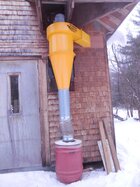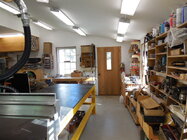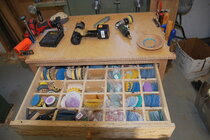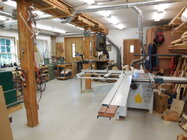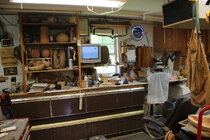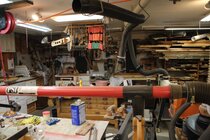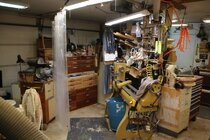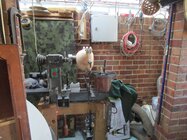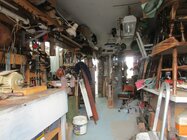I’m in the planning stages of a new shop and looking for photos to steal ideas from what others have done.
-
May 2025 Turning Challenge: Long Neck Hollowform! (click here for details) -
Congratulations to Phil Hamel winner of the April 2025 Turning Challenge (click here for details) -
Congratulations to Paul Hedman and Donna Banfield for "Fire and Ice" being selected as Turning of the Week for 5 May, 2025 (click here for details) -
Welcome new registering member. Your username must be your real First and Last name (for example: John Doe). "Screen names" and "handles" are not allowed and your registration will be deleted if you don't use your real name. Also, do not use all caps nor all lower case.
You are using an out of date browser. It may not display this or other websites correctly.
You should upgrade or use an alternative browser.
You should upgrade or use an alternative browser.
Show us your shop
- Thread starter Webb Willmott
- Start date
- Joined
- Feb 28, 2021
- Messages
- 1,597
- Likes
- 1,399
- Location
- Roulette, PA
- Website
- www.reallyruralwoodworks.com
Already a couple threads on that , here's one for example though it is just lathe area related... https://www.aawforum.org/community/threads/photo-of-your-workstation.18551/
Your term "new shop" seems a bit vague.
Are you looking for ideas for a new stand-alone building?
An addition to the house?
Converting an existing space into a small turning shop?
Are you looking for photos of the buildings?, layouts of tools and storage inside the shop area?
What do you plan to do in the shop - just woodturning, flatwood, more? A few arbitrary photos might not be of much use.
I built a 24'x62' building for my shop. I tell people I built it with my bare hands but I lie - I used tools.
JKJ
Are you looking for ideas for a new stand-alone building?
An addition to the house?
Converting an existing space into a small turning shop?
Are you looking for photos of the buildings?, layouts of tools and storage inside the shop area?
What do you plan to do in the shop - just woodturning, flatwood, more? A few arbitrary photos might not be of much use.
I built a 24'x62' building for my shop. I tell people I built it with my bare hands but I lie - I used tools.
JKJ
Thanks you Brian for the link. Most helpful. I’m interested in seeing the man caves since it’s a place that keeps me out from under my wife’s feet, off the streets and out of the bars. Sometimes a shop is just a shop but sometimes it’s a man cave.
Sorry to be so vague John. I lost my shop when we moved and currently all my tools are on wheels and when I want to work on something, I take over the garage. I am debating building an addition to the garage or wait till we move if we find a house we like. Since I’m retired I’m finding time in a makeshift shop would be better if it was a man cave, therefore I’m planning for a new shop.
I’m interested in how others have set up their shop. More so what they do with limited space. Other things like tool storage and racks/cabinets, chip containment, etc…. Type of woodwork depends on needs and wants.
Sorry to be so vague John. I lost my shop when we moved and currently all my tools are on wheels and when I want to work on something, I take over the garage. I am debating building an addition to the garage or wait till we move if we find a house we like. Since I’m retired I’m finding time in a makeshift shop would be better if it was a man cave, therefore I’m planning for a new shop.
I’m interested in how others have set up their shop. More so what they do with limited space. Other things like tool storage and racks/cabinets, chip containment, etc…. Type of woodwork depends on needs and wants.
I have a small shop and most things are on wheels, I have posted it here before sometime this year.Thanks you Brian for the link. Most helpful. I’m interested in seeing the man caves since it’s a place that keeps me out from under my wife’s feet, off the streets and out of the bars. Sometimes a shop is just a shop but sometimes it’s a man cave.
Sorry to be so vague John. I lost my shop when we moved and currently all my tools are on wheels and when I want to work on something, I take over the garage. I am debating building an addition to the garage or wait till we move if we find a house we like. Since I’m retired I’m finding time in a makeshift shop would be better if it was a man cave, therefore I’m planning for a new shop.
I’m interested in how others have set up their shop. More so what they do with limited space. Other things like tool storage and racks/cabinets, chip containment, etc…. Type of woodwork depends on needs and wants.
I am still in need of wood storage areas, perhaps a whole second building specifically for wood. No, I do not have too much wood! I guess it depends on how much space you have, then learning to fit every thing into the space allowed, and then move things around a bunch of times till you have it set up the way that works best for you. I still have a number of things on wheels, just because....
robo hippy
robo hippy
I’ve only been retired for 18-19 years so I’m still learning. When we moved to the farm I had to move everything from my last shop to mostly 1/2 of a 2-car garage.I want to work on something, I take over the garage. I am debating building an addition to the garage or wait till we move if we find a house we like. Since I’m retired I’m finding time in a makeshift shop would be better if it was a man cave, therefore I’m planning for a new shop.
My mostly-private space in the house has the big piano, guitars, brass, accordions, small library, etc so every thing else is in the shop I built down by the barn: the office with the big computer workstation, small library and reading chair, the overflow music area so I can play loud any time of the day (electric piano, cello, extra brass), woodturning area, flatwood tools, woodturning area, wood storage, welding room, little machine shop, equipment maintenance tools, air compressor dust collector, and central heat and air. I’m thinking of adding a bathroom and small kitchen area but undecided.
If building or even moving into an existing space, I recommend planning carefully first. When planning my shop, before I put in the first structural post I had filled a big notebook with everything including doors/windows, internal walls, major tool locations, position of every electrical receptacle, light fixture, and compressed air outlet. I like to think that up-front effort prevented some last-minute changes and long-term regrets. My only regret now is not building larger but this nicely fit the space and budget without considerably more dirt and tree removal time/efffort.
The flat wood area also accommodates some essential woodturning overflow: sharpening, bandsaw, extra workbench, etc.
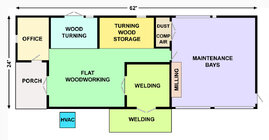
Primary lathe and some tools.
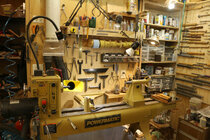
Some of the turning wood storage and drying areas. I only turn dry wood.
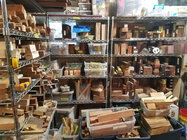
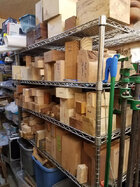
I’ll be in the same boat as you when I get too old to run this farm and sell it and move - I’m thinking of a small house with a big garage - a friend of mine added a 4-car garage when he had his house built. Was never sorry.
JKJ
- Joined
- Feb 28, 2021
- Messages
- 1,597
- Likes
- 1,399
- Location
- Roulette, PA
- Website
- www.reallyruralwoodworks.com
if it wasn't for SWMBO, I'd probably just have a big 6 car garage and build an apartment loft in it, who needs a house?I’ll be in the same boat as you when I get too old to run this farm and sell it and move - I’m thinking of a small house with a big garage - a friend of mine added a 4-car garage when he had his house built. Was never sorry.
JKJ
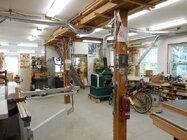
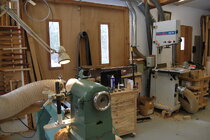
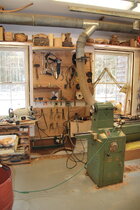
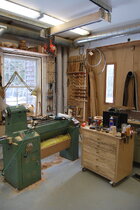
This is my bolthole, built and improved over nearly 40 years, across the yard from my house. 1100 square feet, 9' ceilings, woodstove and electric heat pump.. Equipped for custom cabinetmaking, it would be a lot smaller and simpler if it were just a turner's shop. The lathe, bandsaw, grinder, tool racks and dust collector switch are all within a few steps of each other.
If you can pin down the location of your lathe, an overhead shelf (box) can be really handy. I didn't like my lighting and wanted to add more. I figured having it down closer would help, and having storage above would be a bonus. I bult a 4' long box that got screwed to the ceiling. The underside is covered in lights, and my stereo receiver and assortment of chucks, spare VFD, and a few other odds & ends live above. I also have chuck wrenches, remote for dust collector and some other small tools hanging off it.
If starting from scratch, big shop or small, I'm suddenly deciding that the two single most important decisions for a turner are the location of the lathe(s) and the location of the dust collector. This relationship will help you plan ahead of time how to efficiently and effectively get ducting to the lathe without having to go overhead, below, or spin 'round-n-'round with the duct.
In my small shop (dedicated single car garage in size, 11'x22' wall to wall), I have the dust hoods at the lathes, and their associated duct, more or less on the same horizontal plane as the lathe headstock and the inlet to the 650cfm, 2-bag dust collector. I used straight steel pipe for as much of the system as possible, screwed together and sealed. The two lathes are as close to being up against the wall as the collector duct and dust hood allow. Elevation changes (ducting down at the floor or up at the ceiling) rob suction power due to the air stream having to fight gravity (albeit at a very small rate for dust, moreso if you decide to collect chips, which I don't), and they require more elbows. Elbows flat out steal suction power. Every 90 degree elbow has the same suction drop as 5' of straight pipe. 45 degrees= 2.5' of pipe. And that is for sheet metal duct.
Plastic collector hose robs power due to its ribs, causing air turbulance in the duct, use it as little as possible.
Consider this relationship, and how to keep your ducting as straight, simple, and horizontal as possible, and you'll find that even a 20+ year old, double felt bag, 1hp collector with an efficient intake hood design (no shortage of talk about that in the last 12 months) will gobble up all the airborne dust you can make. After that, lay out for benches, saws, grinders, mini fridge, etc. Have fun!
In my small shop (dedicated single car garage in size, 11'x22' wall to wall), I have the dust hoods at the lathes, and their associated duct, more or less on the same horizontal plane as the lathe headstock and the inlet to the 650cfm, 2-bag dust collector. I used straight steel pipe for as much of the system as possible, screwed together and sealed. The two lathes are as close to being up against the wall as the collector duct and dust hood allow. Elevation changes (ducting down at the floor or up at the ceiling) rob suction power due to the air stream having to fight gravity (albeit at a very small rate for dust, moreso if you decide to collect chips, which I don't), and they require more elbows. Elbows flat out steal suction power. Every 90 degree elbow has the same suction drop as 5' of straight pipe. 45 degrees= 2.5' of pipe. And that is for sheet metal duct.
Plastic collector hose robs power due to its ribs, causing air turbulance in the duct, use it as little as possible.
Consider this relationship, and how to keep your ducting as straight, simple, and horizontal as possible, and you'll find that even a 20+ year old, double felt bag, 1hp collector with an efficient intake hood design (no shortage of talk about that in the last 12 months) will gobble up all the airborne dust you can make. After that, lay out for benches, saws, grinders, mini fridge, etc. Have fun!
Last edited:
john lucas
AAW Forum Expert
2 things were important in my shop. The lathe #1 and the table saw. I needed to be able to rip boards as long as 12 feet and cut up 4x8 plywood. This meant that I put tge saw at an angle so I could open tge garage door for ripping long work. I put my lathe at an angle to allow easy access for clean up. My sharpening station and a tool box with sandpaper and other turning tools is on rollers so I can move them out of the way for ripping plywood. All other power tools are on rollers as well. I roll them out for use and back when not needed. I can also roll them out of the way for larger projects.
View: https://youtu.be/5bYad0qvnB4?feature=shared
I forgot to mention a small detail that helps with chip cleanup.
I position a huge plastic tub under the lathe and against the wall which catch most of the chips for the kinds of things I usually turn. I had a similar one under a second lathe until recently when I gave the lathe to a friend. It's size and position doesn't get in the way of my feet and stance. I periodically dump and spread out the savings in the woods where they eventually turn back into soil.
A small tub at the end is for used sandpaper, paper towels, etc. I understand having the lathe close to a wall doesn't suit some people but it has some big advantages for the way I work and the things I like to turn the most.
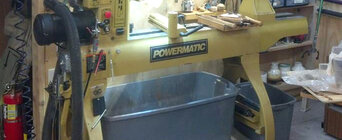
And of course, if you have the space, a powerful cyclone dust collector is a big help to minimize the need to clean up shavings. I built a sound-insulated closet for the air compressor and cyclone with 5hp motors - both, especially the cyclone, are SO loud.
JKJ
I position a huge plastic tub under the lathe and against the wall which catch most of the chips for the kinds of things I usually turn. I had a similar one under a second lathe until recently when I gave the lathe to a friend. It's size and position doesn't get in the way of my feet and stance. I periodically dump and spread out the savings in the woods where they eventually turn back into soil.
A small tub at the end is for used sandpaper, paper towels, etc. I understand having the lathe close to a wall doesn't suit some people but it has some big advantages for the way I work and the things I like to turn the most.

And of course, if you have the space, a powerful cyclone dust collector is a big help to minimize the need to clean up shavings. I built a sound-insulated closet for the air compressor and cyclone with 5hp motors - both, especially the cyclone, are SO loud.
JKJ
I can relate to that!I have been rearranging lathe position off and on. Basically I have not enough room and no space to enlarge into , so its a case fine tuning the fine tune

